
Many Americans report that their relationships with loved ones continue past death in some way, according to a recent Pew Research Center survey.
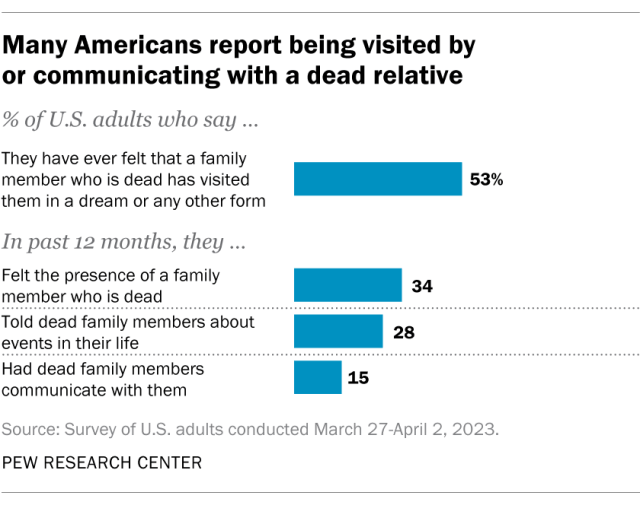
Around half of U.S. adults (53%) say they’ve ever been visited by a dead family member in a dream or some other form. And substantial shares say they’ve had interactions with dead relatives in the past 12 months:
- 34% have “felt the presence” of a dead relative
- 28% have told a dead relative about their life
- 15% have had a dead family member communicate with them
In total, 44% of Americans report having at least one of these three experiences in the past year.
Women are more likely than men to say they have had these kinds of interactions with dead family members. And people who are moderately religious are more likely than others – including those who are highly religious and those who are not religious – to have experienced these things.
The survey was conducted March 27-April 2, 2023, among 5,079 adults on the Center’s American Trends Panel. It included Americans of all religious backgrounds, including Jews, Muslims, Buddhists and Hindus. But there are not enough respondents from these smaller groups to report on their answers separately.
While the survey asked whether people have had interactions with dead relatives, it did not ask for explanations. We don’t know whether people view these experiences as mysterious or supernatural, or whether they see them as having natural or scientific causes, or some of both.
For example, the survey did not ask what respondents meant when they said they had been visited in a dream by a dead relative. Some might have meant that relatives were trying to send them messages or information from beyond the grave. Others might have had something more commonplace in mind, such as having dreamt about a favorite memory of a family member.
Experiences with being visited by a dead relative
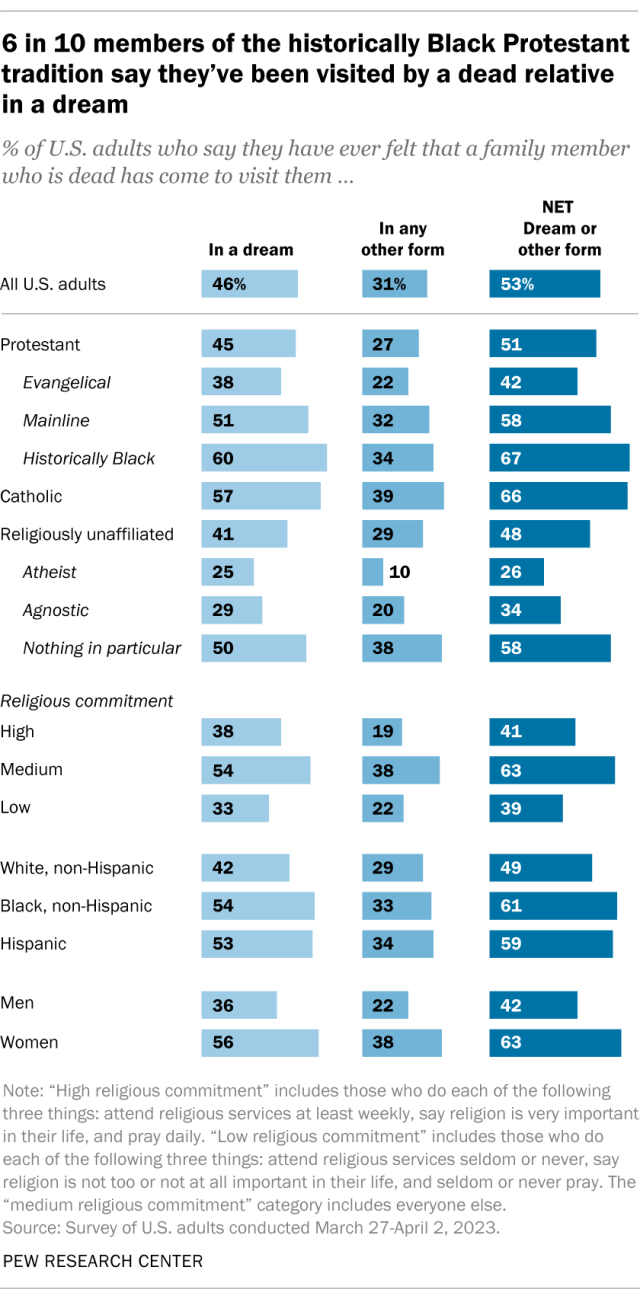
Overall, 46% of Americans report that they’ve been visited by a dead family member in a dream, while 31% report having been visited by dead relatives in some other form.
Roughly two-thirds of Catholics (66%) and members of the historically Black Protestant tradition (67%) have ever experienced a visit from a deceased family member in some form. Evangelical Protestants are far less likely to say the same (42%).
Roughly half (48%) of Americans who are religiously unaffiliated – atheists, agnostics, and those who report their religion is “nothing in particular” – say they have ever been visited by a dead relative in a dream or other form. However, those who describe their religion as nothing in particular are much more likely to say they have ever been visited by a deceased loved one (58%) than are agnostics (34%) and atheists (26%).
Recent contact with deceased relatives
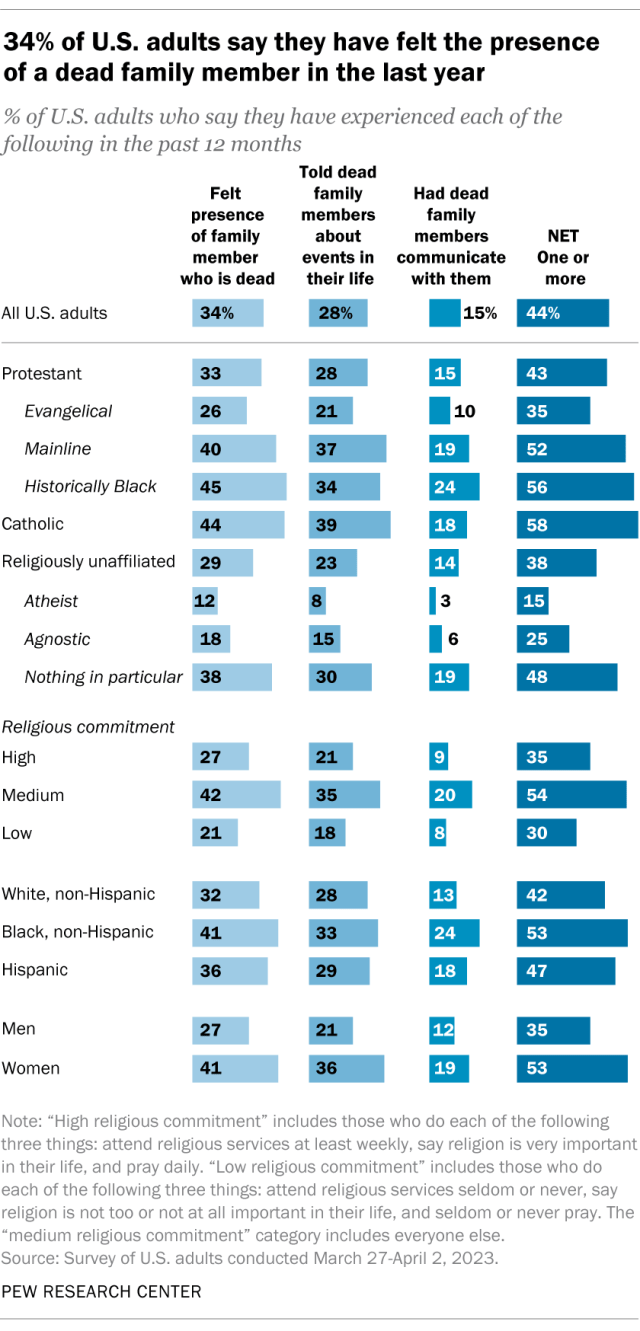
When asked about recent experiences – things that have happened in the last 12 months – 34% of Americans say they have felt the presence of a dead family member and 28% say they have told dead family members about events in their life. Fewer respondents (15%) say a deceased family member has communicated with them in the past year.
Women are more likely than men to say they had at least one of these three experiences in the last year (53% vs. 35%). For example, women are more likely than men to say they recently have felt the presence of a dead family member (41% vs. 27%).
When it comes to religion, about half or more of Catholics (58%), members of the historically Black Protestant tradition (56%) and mainline Protestants (52%) say they have had at least one of these three experiences in the last year – significantly more than the 35% of evangelical Protestants who say the same.
Relatively few atheist (15%) or agnostic (25%) adults report any of these experiences over the last 12 months. In contrast, roughly half (48%) of those who say their religion is nothing in particular reported one of these experiences.
These experiences also differ by Americans’ religious commitment, as measured by a scale that includes indicators of religious service attendance, prayer frequency and self-assessments of religion’s importance in one’s life.
Americans with medium levels of religious commitment are more likely than those with either higher or lower levels of religious commitment to say they’ve felt the presence of a family member who is dead, told a dead family member about events in their life, and felt a dead relative communicate with them in the past year.
Summing up this pattern in another way: People who are moderately religious seem to be more likely than other Americans to have these experiences. This is partly because some of the most traditionally religious groups – such as evangelical Protestants – as well as some of the least religious parts of the population – such as atheists and agnostics – are less likely to report having interactions with deceased family members.
Complete Article ↪HERE↩!
A friend at the end
— Volunteers ensure dying patients don’t face death alone

Trinity Health’s palliative care program ‘No One Dies Alone’ sends volunteers to be with patients in final hours, give families respite
By Daniel Meloy
Dying is a personal — and often difficult — thing to discuss.
From choosing hospice care and drafting wills to an entire continuum of end-of-life care, there are many views about what’s best.
But there’s one thing most people can agree on: no one wants to die alone.
And thanks to a group of volunteers through Trinity Health, no one has to.
In 2005, a team of people at the Catholic health care system started No One Dies Alone, a palliative care program that assigns volunteers to be present with patients who are nearing death, standing by their bedside when family and friends can’t be present.
“No One Dies Alone is a comfort companion program for those patients who don’t have family or whose family can’t be present at the bedside 24/7,” said Barbara Stephen, bereavement specialist in the volunteer department at Trinity Health Oakland and Trinity Health Livonia. “Whether family and friends are out of state, or can’t get in right away, or are in need of respite care, we provide volunteers who can be there if needed. We’re a friend who looks for any kind of distress and keeps them company.”
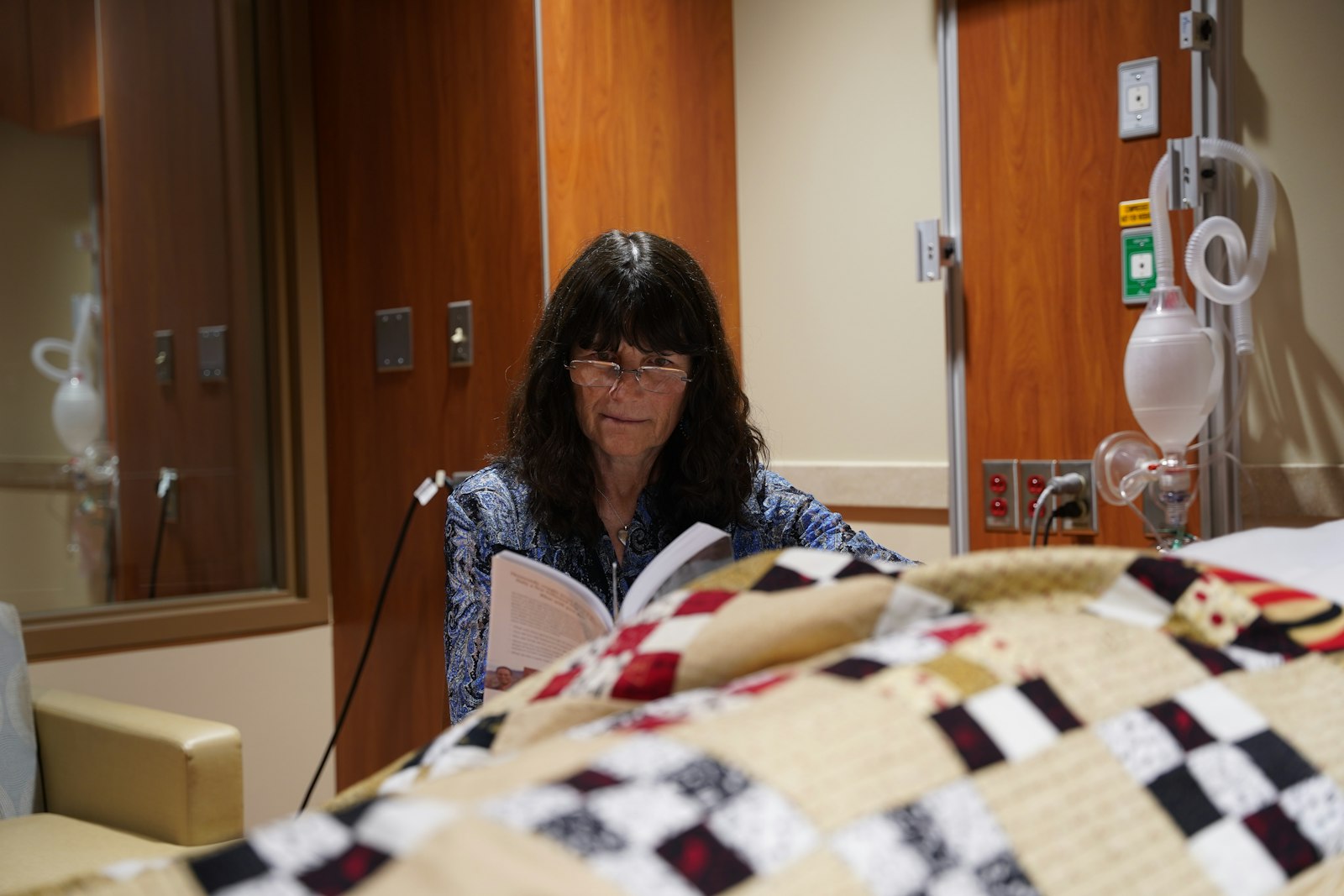
The program started after Trinity Health’s Palliative Care Program did a study on end-of-life care around the country, noting 50% of patients die in a hospital, and of those, about 10-12% die alone, without family and friends at their side.
Through No One Dies Alone, volunteers keep patients company in their final days, doing everything from reading to patients, holding their hand, or calling a nurse if a patient is in discomfort.
“We are there to be at the bedside,” Stephen told Detroit Catholic. “We do a lot of hand-holding. We don’t do nursing care, but what we do is a lot of talking, prayers if they want, and just being that second set of eyes. If we see some distressing signs, like pain or a need for medical care, we call the nurse. We get a wet washcloth if they are running a fever, or Chapstick when their lips are chapped. We’re there to be that friend by the bedside, keeping an eye on them, letting them know they are not alone.”
No One Dies Alone took a hiatus during the COVID-19 pandemic, when volunteers weren’t permitted in hospitals.
The program rebooted last September, operating out of Trinity Health’s Oakland (Pontiac) and Livonia locations, with 38 volunteers at Oakland and 29 in Livonia.
No One Dies Alone volunteers typically operate on three-hour shifts and receive a brief report about the patient, including a person’s family situation, interests and condition. Volunteers often build a rapport with the patient’s family, stepping in to allow family members to get a bite to eat or a change of clothes at home.
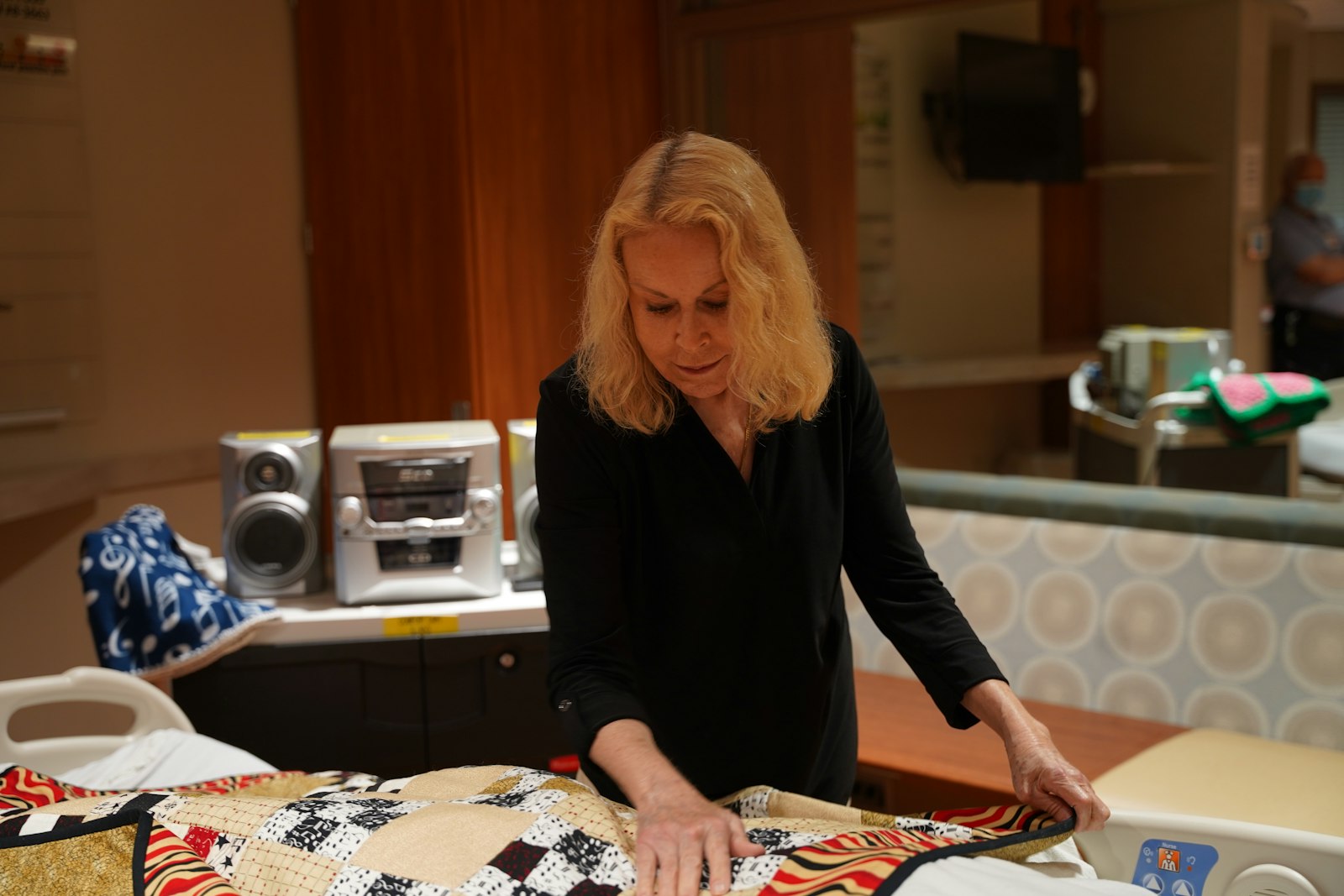
“The volunteer who is coming in to (watch over) the person who is dying often is not able to talk to the patient, but they do talk with family, who are grateful they are there,” said Kelly Herron, visit coordinator for No One Dies Alone. “They appreciate that someone is stepping into the space for their family, knowing their loved one is being watched over.”
Volunteers are not meant to act as medical personnel or hospice workers. Their work is more a ministry of presence, Herron said.
“As a volunteer, our role is limited because we are there to hold a space,” Herron said. “It’s about showing up and being a companion, being willing to talk about the things they want to talk about. It’s about being a friend and putting them first, not being afraid to listen to them talk about what they are feeling as they near the end.”
Sometimes, volunteers can even fulfill special requests, such as having terminal patients see their pets one last time.
“A lot of patients have pets at home, and when we ask them if they have a wish, often they regret they’ll never see their dog or cat again, so we bring the pets in — as long as they are updated on their shots — so they can be with their owner,” Stephen said.
Sometimes, volunteers are a shoulder for family members struggling with the loss of their loved ones, Stephen added.
“We had a young mom who was dying, and she had a 7-year-old daughter, and the dad didn’t know how to tell the daughter,” Stephen said. “(The mother and daughter) shared a birthday, and we knew the mom wasn’t going to make it to the next birthday. We asked what they usually do for their birthday, and the dad said they always have a tea party. So we got the mom out of her hospital gown, had some nice pajamas for her, and got the daughter dressed up. My husband went to Costco to get balloons, and we had a tea party. We took pictures, not only for the daughter to remember, but for the mom to hang onto that memory. It’s not easy losing your mother at 7, but it was a lovely time.”
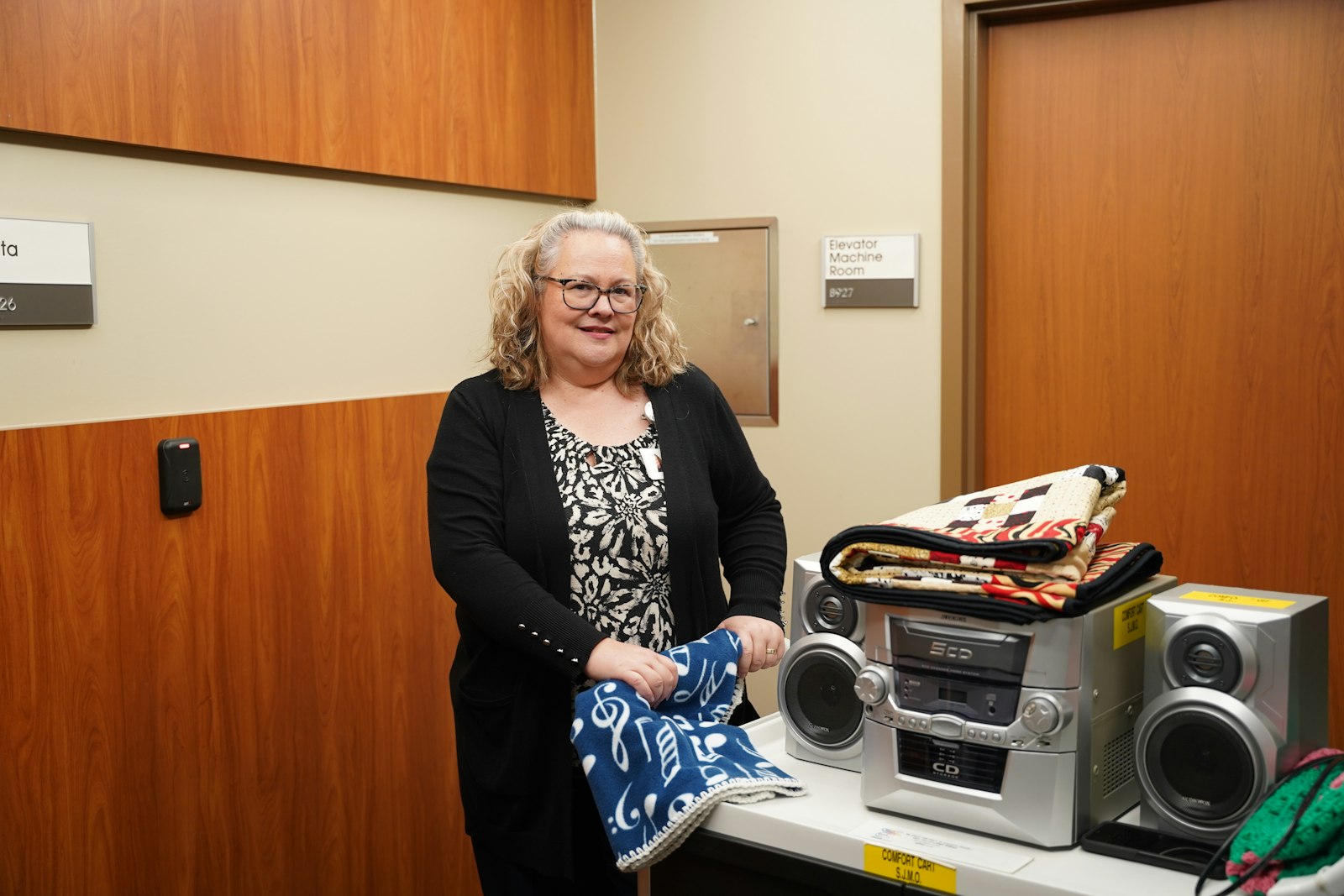
Most visits are more low-key, but the idea is the same: being with people in their hour of need.
Herron recalls her own experience of being with her own mother when she died, adding it was a comfort to both of them to know she wasn’t alone. It was Herron’s time as a No One Dies Alone volunteer that prepared her for her mother’s death, she said.
“When my mom died, I was sitting there with her,” Herron said. “Everyone thought she probably would die soon. It was the middle of the night, everyone went to sleep, and I remember holding my mom’s hand, saying, ‘I’m going to go to sleep. You go to sleep too, and I’ll talk to you in the morning. But I’m right here.’ I was just pulling my hand back to demonstrate that I was falling asleep, but I didn’t close my eyes. I just looked at her, and she opened her eyes and look at me before she died.
“To me, that’s why we do this,” Herron added. “If at any point, someone is going to open their eyes or squeeze their hand, it’s so comforting that someone is there — that they are not forgotten, that they are not alone, and that it matters to someone as you are making that transition.”
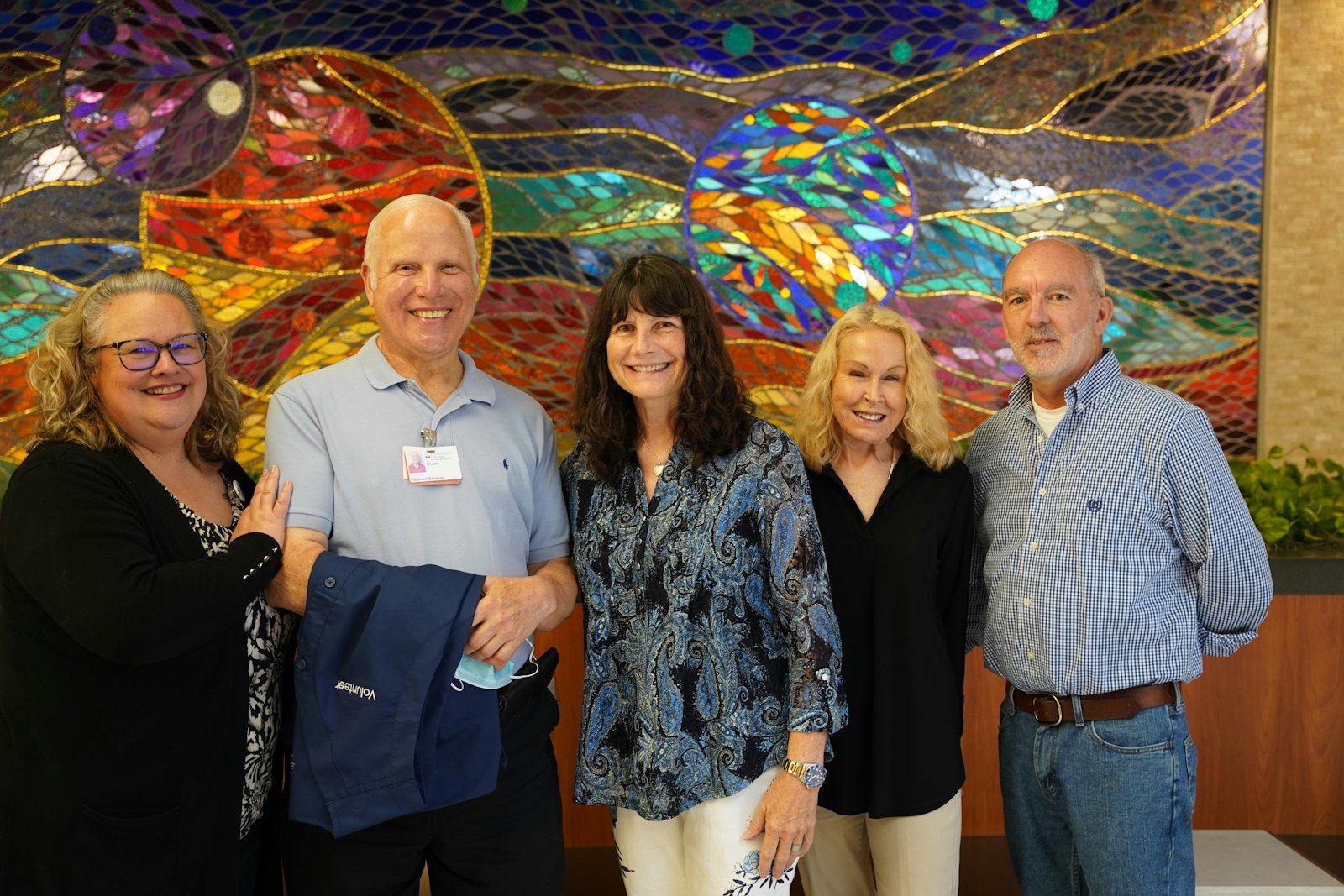
While No One Dies Alone is a comfort to the dying and their families, it’s also an added benefit to hospital medical care staff, who appreciate having an extra set of eyes and ears in the room.
“Our nurses are so compassionate, and they just want to be there. They don’t want anybody to be alone when it is the end of someone’s life, but they have a patient load,” Stephen said. “So when they see us, they are so excited. When our volunteers come in, the nurses ask if they can get us a cup of coffee, or if we need anything. They take really good care of us, because they appreciate there is always someone there with their patients.”
Complete Article ↪HERE↩!
When disease ravaged her body, Sara was crystal clear about what she wanted.
— Here’s what she chose to do
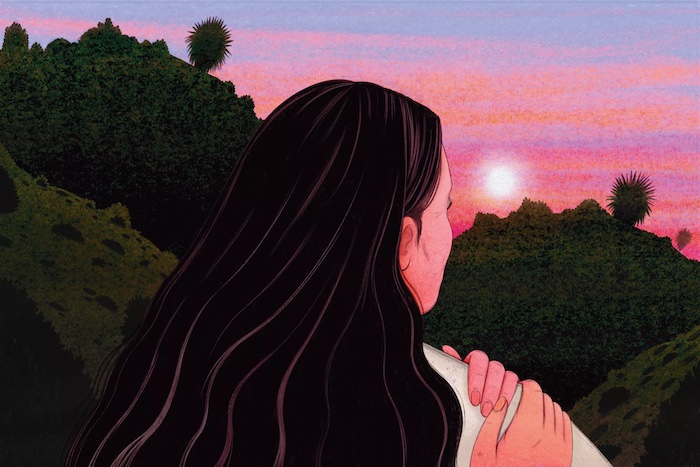
By Nina Rota
A man from the home care agency calls on a Monday morning. “The caregivers are complaining. It’s too hard to transport Sara, to move her from the bed to the wheelchair and onto the stairlift. You need a lift or some other assistive device.”
A rush of sadness settles into my body. The end has arrived. “Sara is leaving on Friday,” I say, “Can we hold out till then?”
“Oh,” he says, and pauses, “I’m so sorry to hear this.”
My partner, Sara Flint Greenberg, was nearing the end of her nine-month journey through amyotrophic lateral sclerosis, more commonly known as ALS or Lou Gehrig’s disease, and she would take her life on Friday.
There is nothing more we could do. Her body has been ravaged by this devastating disease and she has been crystal clear, from the beginning, that she would leave when she can no longer take care of herself.
There are steps to the end of this journey.
Later that Monday morning, Sara speaks with a doctor, answering some required questions. Does she have less than six months to live? Is she mentally capable of making the decision to end her life? Can she self-administer the medication? Luckily, the session is short. Sara spends much of her day on a machine which helps her to breathe. Too much talking leaves her gasping.
On Wednesday morning Sara speaks with a second doctor who agrees that she qualifies to receive medications that assist in dying under the requirements of the California End of Life Option Act. The medication that will allow Sara to leave will be ready on Friday.
On Wednesday afternoon we celebrate our wedding. Sara and I marry in the late November light of our living room. I am not strongly attached to marriage, but as the day of Sara’s passing drew closer, I felt an overwhelming need to express the beauty of our love in ceremony.
The temporary chuppah is held over our heads by Sara’s sons Aaron and Jacob, our friend Audrey and a caregiver. We have found an independent rabbi to marry us because I am not Jewish. The rabbi is adorable in her Converse sneakers, covered with stars, as she takes us through this bittersweet ceremony. The ceremony is short because Sara is exhausted. It is her last gift to us, her family.
On Friday morning, our friend Margaret arrives from New York, kisses Sara on the cheek and tells her she loves her. It is all anyone can do. Audrey is in the kitchen. She has been with us for days, helping us through.
Later in the morning, a rabbi from our synagogue arrives to help us say goodbye to Sara. Margaret and Audrey go downstairs to wait. They sit, mostly silent and sometimes hold hands. The room feels heavy. They can hear Sara breathing above them, but they know she will not be there for long. It is one of the most reverent acts of love: to witness in silence the death of another.
At noon, Sara takes a pill to prevent nausea and vomiting when she takes the medication that will end her life. I sit beside her on the couch, Aaron is at her feet and Jacob is across from her. The rabbi is just beyond our circle as he begins to guide us through our final words. Everything is said on the edge of tears. We listen closely to hear our soft voices.
Sara regrets, deeply, that she will never see her grandchildren. She will not see her sons grow further into their lives or settle down with partners and start families. She gathers her breath and questions them closely because this is her last chance. She wants to know what their futures looks like because she will not be there.
There are apologies because anything left to be said has to be said. Death demands it. We make promises because who would say no? Sara would do anything for her sons and I promise to do the same. We celebrate Sara’s bravery. She left a longtime marriage, late in life, and jumped into love with me. And the bravery she shows today in making this choice.
The rabbi asks Sara where we can find her after she’s gone. “Walking in these hills,” she says, of the land surrounding our home where she once walked every day. She is now struggling to breathe and is silent. We are left with silence and the presence of love. We will carry this love everywhere we go.
It is almost an hour after Sara took the anti-nausea pill. She must take the medication now or wait for another day. The hospice nurse has not yet arrived. We call our hospice provider. They tell us to mix the medication with apple juice and give Sara sorbet because the taste can burn her throat. Sara reaches for the medication with both hands. She is ready to leave.
As the medication moves through her body, she prays in Hebrew: “HaShem Sheli, HaShem Sheli, ya’azor li” (“My God, my God, help me”). She recites the Shema, a centerpiece of prayer services in Judaism. As she draws closer to leaving, her last words are “Thank you, thank you,” a beautiful sentiment and a sign, I hope, that she is at peace.
Sara slides slowly down the couch, her cheek resting against the back of my hand. I feel life in her body, but after half an hour I am not sure. The hospice nurse has arrived. I ask him if she has passed. No, she is still here. Another half hour and I ask again. He checks her pulse. She has left.
My beautiful Sara is gone.
Complete Article ↪HERE↩!
A Moment in Time
— “Explaining Death to a Toddler”

Walking by a tree the other day, I noticed one brown leaf among the flourishing green. I wondered, “Why is it that this specific one died?”
By Rabbi Zach Shapiro
Dear all,
Walking by a tree the other day, I noticed one brown leaf among the flourishing green. I wondered, “Why is it that this specific one died?”
The question weighed heavily, as Ron and I are preparing to explain the death of a loved one to our toddler children. We know there will be many questions:
”Why?”
”Why now?”
”What does death mean?”
”Will something happen to you?”
”If so, who will take care of me?”
While the conversation will be difficult, we also know it needs to be straight-forward. When talking about death, it’s really important to keep the following in mind:
- Don’t use euphemisms. (No one “passed away” or “went to sleep.” The person died.”)
- It’s ok to express your own emotions and not hide them.
- Make sure you answer the question the child is actually asking. Be brief and simple about it.
- It’s ok to share: “a body stopped working” and: “it doesn’t move or eat or play anymore.” If the child asks if the body is like a toy that needs a new battery, explain that living things can’t get new batteries like toys do.
- Your child may or may not ask questions. Some questions may unfold over time.
Also – remember this. Every death is different. Sharing the death of an older adult is very different experience than sharing the death of a young person. And different children will respond in different ways.
Mind you, it’s one thing to offer this advice in my moment in time. It’s another to sit and have the conversation with our children. We will rehearse it. We will prepare our answers. But we will also ensure that we are not so over-prepared that we come off as staged.
It’s a delicate balance. But so is life.
With love and shalom.
Rabbi Zach Shapiro
Complete Article ↪HERE↩!
From Christianity to Buddhism
— A Comprehensive Guide to Religious Funerals

By EMMANUAL
Funerals hold significant cultural and religious importance worldwide. These rituals mark the end of a person’s life and provide an opportunity for communities to mourn, remember, and celebrate the departed soul. Regardless of different religious beliefs, funerals share a common thread of honoring the deceased and offering solace to the grieving. Let’s explore the diverse types of funeral practices observed in different religions around the globe, each reflecting the unique perspectives on life, death, and the afterlife.
1. Funeral Practices in Christianity:
Christianity, one of the world’s largest religions, views death as a transition to an eternal life with God. Christian funerals typically involve a somber yet hopeful tone, focusing on the belief in resurrection and salvation. Funeral services often include prayers, hymns, scripture readings, eulogies, and the sharing of memories. Burial is a common practice, with cemeteries serving as sacred grounds for the departed.
2. Funeral Customs in Islam:
In Islam, death is considered a natural part of life, and the afterlife is a fundamental belief. The Janazah (funeral) rituals are guided by Islamic principles and usually take place soon after death. The body is washed, shrouded in a simple cloth, and a specific prayer, Salat al-Janazah, is performed in congregation. Muslims bury their deceased facing Mecca, emphasizing humility and equality in death.
3. Jewish Funeral Traditions:
Judaism, with its rich traditions and customs, approaches death as a continuation of the soul’s journey. Jewish funerals prioritize the prompt burial of the deceased, often within 24 hours of death. The deceased is ritually washed (Tahara) and dressed in a plain white shroud (Tachrichim). Eulogies are avoided, and the focus is on prayers, Psalms, and the sharing of memories during the funeral service.
4. Hindu Funeral Ceremonies:
Hinduism, a complex and diverse religion, regards death as part of the soul’s cycle of rebirth (Samsara). Antyesti, or the Last Rites, is a crucial funeral ceremony in Hindu traditions. The body is cremated, and the ashes are often scattered in a sacred river. Hindu funerals may also include other rituals such as Pinda Daan, offering rice balls to the deceased for spiritual liberation.
5. Buddhist Funeral Observances:
Buddhism, known for its teachings on impermanence, interprets death as a transition to another life or state. Buddhist funerals vary among different cultures but commonly include chanting, reciting sutras, and performing rituals to guide the soul towards a positive rebirth. Cremation is a widespread practice, and some Buddhist communities also practice sky burials or water burials.
6. Sikh Funeral Rites:
Sikhism emphasizes the unity of the soul with the eternal creator, and death is seen as a merging of the soul with the divine. The Antam Sanskar, or Last Rites, involves bathing the body, followed by prayers and hymns from the Guru Granth Sahib (Sikh scriptures). Sikhs opt for cremation, considering it a way to liberate the soul from the cycle of birth and death.
7. Traditional Chinese Funeral Customs:
Chinese funeral traditions are deeply rooted in ancestral worship and veneration. Chinese families pay great respect to their ancestors and believe in maintaining strong familial connections even after death. Funeral rites include elaborate ceremonies, offerings, and prayers. Burial, cremation, and entombment in family graves are practiced based on regional and cultural differences.
8. Native American Funeral Traditions:
Native American communities have diverse spiritual beliefs, each with its unique funeral customs. The concept of death often involves a cyclical view of life and rebirth. Funeral practices include rituals, dances, and ceremonies that honor the deceased and guide their spirits to the afterlife. Burial methods vary, such as ground burials, tree burials, or sky burials.
9. African Traditional Funeral Ceremonies:
African traditional funeral customs are deeply connected to ancestor veneration and the spiritual world. These rituals differ widely across the continent’s diverse cultures. Funerals are elaborate events, often lasting several days, and include dancing, singing, and feasting. Burials may take place in family graveyards or sacred sites.
10. Ancient Egyptian Funeral Rituals:
The ancient Egyptians believed in an afterlife and devoted considerable effort to ensure a smooth transition for the deceased. Mummification was a significant part of the funeral process, preserving the body for the journey to the afterlife. Elaborate ceremonies and rituals were conducted to honor the deceased and seek protection in the afterlife.
11. Modern Secular Funeral Practices:
In modern times, secular or non-religious funerals have gained popularity. These services often focus on celebrating the life of the deceased rather than emphasizing religious beliefs. They may include personalized elements, music, and readings that reflect the individual’s interests and values.
12. Comparative Analysis of Funeral Practices:
When examining funeral practices across various religions, common themes of reverence for the deceased and comforting the bereaved emerge. Despite differences in rituals, these practices share the purpose of providing closure and honoring the departed soul.
13. Perceptions and Attitudes Towards Death:
Cultural and religious beliefs significantly influence how societies perceive and approach death. Understanding these differences fosters tolerance and compassion in times of grief. Coping with loss is a deeply human experience, transcending cultural boundaries.Funerals, regardless of religious affiliations, are a testament to humanity’s shared experience of life and death. Each type of funeral bears witness to a community’s beliefs, values, and traditions, offering solace to the bereaved and celebrating the life of the departed. Embracing the diversity of funeral practices enriches our understanding of the human journey.
Complete Article ↪HERE↩!
It’s time to legalise assisted dying, in the name of compassion
— In my work as a congregational rabbi I see people die in pain, needlessly

By Rabbi Dr Jonathan Romain
As someone who passionately values the gift of life that we each have, why have I now become head of the campaign in Britain to legalise assisted dying, whereby a person obtains a prescription for life-ending medicine that they themselves take?
It is precisely because of my work as a congregational rabbi and many years of visiting hospitals and hospices, where I see people die in pain, despite the best efforts of medical staff.
They often beg doctors and relatives “Can’t you help me die in peace?”, but at present that is not legal. I see no merit in individuals being forced to live out their last days in misery if they want to avoid it.
In Ecclesiastes we are told that ‘There is a time to be born and a time to die’ (3.2). It is noticeable that it does not stipulate who chooses that moment.
Suicide is rightly discouraged in Judaism, but that assumes the person may otherwise live on for many years if not decades. Assisted dying is for those dying who wish to die well.
If we control all aspects of our life – where we live, what job we have, who we marry – why should we not determine when we leave it if we are facing a terminal illness?
A key factor for those wishing to die is the desire to avoid pain, but for others, it is the lack of control over their bodily functions or the unwelcome image of being sedated into a state of narcotic stupor.
Some might object that assisted dying means ‘playing God’ – but this ignores the fact that we frequently ‘play God’ – doing so every time we give a blood transfusion or provide a road accident victim with artificial limbs. Should we stop doing that? No more hip replacements or heart transplants?
We can believe in the sanctity of life – how precious it is – but that does not mean believing in the sanctity of suffering, or disregarding steps to avoid it. There is nothing holy about agony.
If terminally-ill patients do not wish to live out their last few weeks in pain, for what purpose should they be forced to do so, and in whose interest is it that life is prolonged?
There are strict safeguards being proposed to prevent any abuse. They include the stipulation that the person is terminally ill, is mentally competent and makes the request of their own free will.
In addition, there is a rigorous process for ensuring the above: it can only be initiated if requested by the person him/herself, and they must be assessed by two independent doctors to ensure that they are terminally ill and of sound mind.
On top of this, the person must have been fully informed of palliative care, hospices and other options, while they can change their mind at any time, right up to the last minute.
Meanwhile, the British Medical Association and almost all other Medical Royal Colleges have dropped their previous opposition to assisted dying. That is very significant.
Another persuasive factor is that we are in the fortunate position of knowing in advance what will be the likely effects of permitting assisted dying. This is thanks to the experiences in Oregon, which has the closest system to the legislation being proposed here.
Since it was introduced in 1997, several thousand dying patients per year enquire about assistance to die, but only around 0.4% of the overall deaths in a year opt for it. That is twenty-five years of hard evidence.
It indicates that many people wish to ‘know it’s there’ and have the emotional safety net of knowing they can resort to it if their situation makes life intolerable, but never find they reach that stage.
While many in the religious hierarchy still hold to the traditional opposition to assisted dying, there are a growing number of rabbis who now favour it.
At the same time, attitudes are changing within the general population too. A recent Populus poll revealed that 79% of those from religious backgrounds – defined as people who take their faith seriously enough to attend services at least once a month – said they supported the law being changed. Amongst Jews it was 83%.
If there is a right to die as well as possible, it means having the option of assisted dying, whether or not it is taken up.
It is also a matter of compassion – the compassion not to force other people who are suffering to keep on suffering if they reckon it is time to let go.
We need to tackle it for their sake. But who knows if we ourselves might one day need it?
Complete Article ↪HERE↩!
A Closer Look at the Ceremonies and Traditions of Buddhist Funeral Service
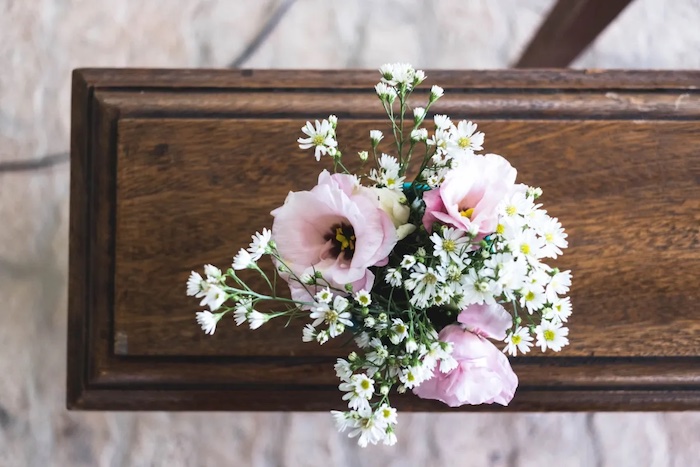
By Nerd Voices
When delving into the realm of funeral services, it becomes evident that the factors of perplexity and burstiness play a significant role in shaping the narrative and experience. Within the context of Buddhism, a unique approach emerges, characterized by a harmonious blend of complexity and variation. In this article, we embark on a journey through the intricacies of Buddhist funeral services, unraveling the distinct elements that make them truly exceptional.
Introduction to the Unique World of Buddhist Funeral Services
A Buddhist funeral service stands as a remarkable testament to honoring and commemorating the life of a departed loved one. Rooted in the profound principles of Buddhism, it weaves together solace and closure for those who embrace this philosophical path. The essence lies not only in bidding farewell but also in facilitating the departed’s transition to a new existence, while extending support and solace to family and friends. Brace yourself as we embark on an enlightening exploration of what unfolds during a Buddhist funeral services, replete with intriguing aspects that set it apart from other funerary rites.

Unraveling the Tapestry of a Buddhist Funeral Service
Buddhism, with its profound history spanning centuries, encompasses both life and death within its embrace. Consequently, it is no surprise that Buddhist funeral services occupy a pivotal role in the process of mourning, honoring the deceased, and offering solace to those in attendance.
The commencement of a Buddhist funeral ceremony often finds its roots in the enchanting chants emanating from sacred Buddhist scriptures. These mellifluous melodies intertwine with prayers, creating an ethereal ambiance of remembrance. Moreover, the ceremony may include the recitation of sutras, skillfully rendered by learned monks or devoted family members. The atmosphere is further enriched by the fragrant offerings of incense and flowers, as well as heartfelt eulogies delivered by kin or close confidants. Remarkably, depending on tradition, one may even encounter moments of serene meditation or other spiritual practices that infuse the service with an aura of profound contemplation.
Central to the fabric of a Buddhist funeral service is the paramount objective of assisting those present in embracing the concept of mortality and finding inner peace within its embrace. In the realm of Buddhism, death is not feared but rather acknowledged as an integral part of life’s cyclical nature. Thus, these solemn moments serve as an opportunity for friends and family to reflect on the impact of loss and to share treasured memories of the departed.
As the ceremony unfolds, the offering of food takes center stage, symbolizing the departed spirit’s passage into an alternate realm. These gestures of culinary homage vary in accordance with local customs, each carrying its own significance and depth of meaning.
Discovering the Meaningful Essence of a Buddhist Funeral Service
In the tapestry of existence, a Buddhist funeral service emerges as a poignant and meaningful tribute to those who have embarked on their final journey. Rooted in compassion and embracing the transient nature of life, this sacred rite serves as a conduit for honoring the spiritual odyssey of the departed while providing solace for those left behind.
At the heart of any Buddhist funeral service lies the mesmerizing art of chanting. Through the recitation of prayers and mantras, a profound reverence for the departed is awakened. Whether performed by family members or revered monks, these sacred utterances transport the mind into a realm where the fragility and vitality of life intertwine.
Equally significant is the act of honoring the deceased through symbolic offerings. Flowers, incense sticks, and favored fruits or food items find their place before an image or statue representing the three jewels of Buddhism: Buddha Shakyamuni, his teachings (Dharma), and the monastic community (Sangha).
Complete Article ↪HERE↩!
